The History of the Borg - Star Trek's Unstoppable Villains
From The Next Generation to Picard Season 3, the Borg are Star Trek's most insidious villains - born from equally epic behind-the-scenes battles.
Many of Star Trek 's most iconic species can be traced back to series creator Gene Roddenberry. However, the iconic and unstoppable Borg are the brainchild of one of his greatest on-set adversaries. Maurice Hurley was a new arrival on The Next Generation' s staff who didn’t see the future the same way Roddenberry did, but was bound to tell stories by his rules. Their conflict gave rise to characters who would help define the entire franchise.
When Roddenberry staffed The Next Generation , he brought many of the writers he worked with on The Original Series back. However, there was a new narrative edict. Starfleet in the 24th Century would've continued to evolve from Captain Kirk's era. He believed there would be no jealousy, tension or any interpersonal conflict within the crew. Roddenberry's lawyer Leonard Maizlish started acting as a de facto producer, allegedly responsible for hiring Hurley to enforce Roddenberry's strict rules. Yet the talented storyteller just didn't know what to do with no crime, conflict or any of the other storytelling staples he was used to from procedurals like Miami Vice and The Equalizer . In order to alleviate this problem in the second season, Hurley wanted to introduce a new kind of villain that couldn't be reasoned with or stopped.
RELATED: Star Trek: How Picard's Assimilation by the Borg Radically Changed the Franchise

Star Trek's Borg Were Originally Going to Be Insects
The central problem between Roddenberry and Hurley was that the latter didn't believe in what he was supposed to sell the other writers. In the documentary Chaos on the Bridge , Hurley called Roddenberry's ideas of the future "wacky doodle." Since he thought they were bad rules, he could only guide them in constructing "bad" episodes. Sometimes writers would even pull an end run and take a story to Roddenberry that bent or broke his rules. Hurley claimed he would "go ballistic" arguing Roddenberry's ideas back at him. Still, he wasn't setting out to make bad Star Trek , so he thought of a solution: insects.
The Ferengi were introduced in Season 1 as the "new Klingons," but they failed to land in that way with the audience. Hurley thought of insects as an unrelenting natural force, and believed that would make a good basis for an alien species to menace the crew all season. Insects proved to be impossible to create on a regular basis, so he instead went with the idea of cybernetic and organic lifeforms -- cyborgs. He dropped the "cy" from the name, and The Next Generation had its most memorable villains. Hurley planned to seed Season 2 with hints to the Borg until revealing them during October sweeps for the first time. However, the 1988 Writers Guild of America strike necessitated a new plan.
Eventually, Hurley used the popular character of Q to bring the Borg into contact with the Enterprise -D in The Next Generation Season 2, Episode 16, "Q Who?". However, they became a looming threat out in the galaxy rather than a regular villain, as the costuming for the Borg proved to be as difficult as crafting believable insects. Hurley envisioned the aliens being mostly disinterested in organic life, only concerned with Starfleet technology. This changed when the villains returned to assimilate Captain Jean-Luc Picard at the end of Season 3. By that time, Hurley had happily moved on from Star Trek .
RELATED: How Seven of Nine Was Rescued From the Borg on Star Trek: Voyager
The Borg Have Become Star Trek's Most Important Villain
Captain Picard and the Enterprise -D crew faced the Borg only nine times in 35 years, including in the film Star Trek: First Contac t and Picard Season 3. However, the Borg appeared in a whopping 23 episodes of Star Trek: Voyager -- in large part because of Seven of Nine, the former Borg turned Starfleet officer. The writers who succeeded Hurley worried that using the Borg too much would've curtailed their threat. Some fans did complain about the prevalence of the Borg in Voyager . Yet that allowed the Admiral Janeway from an alternate future to hobble the Borg Collective in Voyager 's series finale.
The Borg were mostly a thing of the past by the time Picard debuted, with a significant portion of the first season taking place on a "dead" Borg cube. By Season 2, the introduction of a new Borg Queen meant Picard had to again face a mini-collective. However, by then showrunner Terry Matalas and his crew of storytellers knew how to make Roddenberry's rules work. Hurley's unstoppable, unrelenting villains became provisional members of the Federation. Their collective was opt-in only, and their purpose was to stand by a tear in space-time that some future threat would emerge from. Picard could apparently negotiate peace with anyone.
Well, maybe not anyone . The Borg also made him and his son Jack Crusher time bomb for their last-ditch attack on Earth. When Picard faced the Borg Queen in the Picard series finale , he wasn't there to talk. The Borg were seemingly destroyed once and for all by the crew of the Enterprise -D. But Maurice Hurley's creations are too perfect to stay gone. He may not have known how to shape a season of Star Trek , but he inspired its most fascinating and enduring villain because of his frustration.
Create a free profile to get unlimited access to exclusive videos, sweepstakes, and more!
30 years ago, Star Trek's Borg canon was rewritten for the scarier
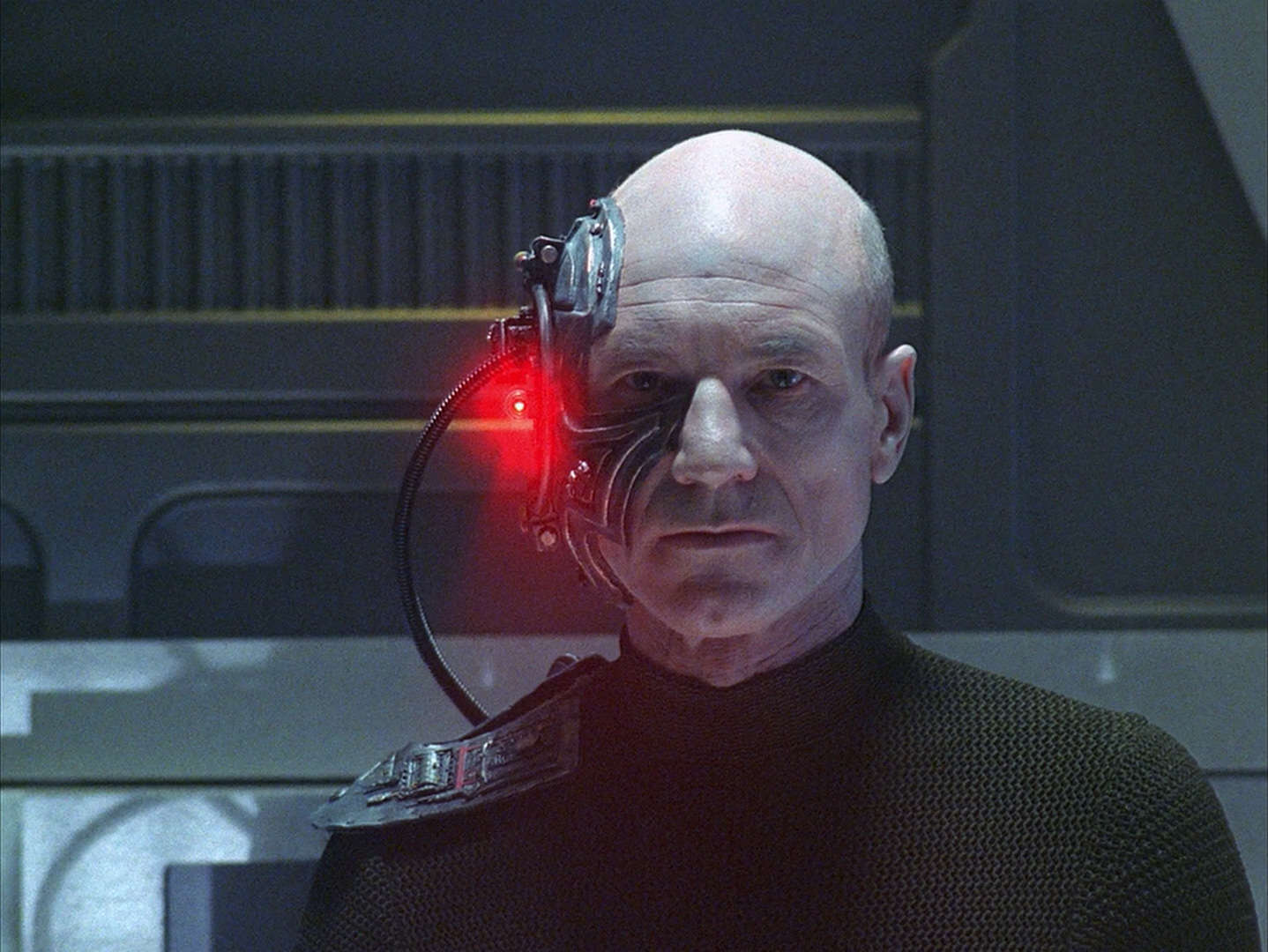
Credit: CBS
Exactly 30 years ago, everything about Star Trek 's Borg Collective changed on a dime with two very brief lines of dialogue. The hivemind cyborg species known as the Borg are, without a doubt, the most famous enemy of the Federation — and Captain Picard specifically. They arrive on the scene reciting their ominous catchphrase, "You will be assimilated," but the bizarre thing is, originally, the Borg weren't interested in assimilating organic lifeforms.
In the beloved and excellent Star Trek: The Next Generation cliffhanger "The Best of Both Worlds Part 1," the Borg underwent a soft reboot that changed everything about Trek canon and influenced the specific plots of First Contact , a ton of Star Trek: Voyager episodes, and, obviously, all of Star Trek: Picard .
"The Best of Both Worlds" — which first aired on June 18, 1990 — contains a moment that you likely forgot about, yet it has massive implications for the Borg and Star Trek as a whole. Here's how it got away with that and why it's still utterly fascinating.
The importance of "The Best of Both Worlds" in the larger scope of Star Trek cannot be overstated. It made multi-part stories in Star Trek viable. It made The Next Generation seem high stakes in a way it never had before. It permanently altered the character of Jean-Luc Picard . But, if you're reading this, you know all of that. Or, at the very least, you remember all of that. We can debate all day long whether it was more chilling when Picard says "We have engaged... the Borg," or when he emerges totally Borgified at the end of the episode and says, "Your life as it has been is over." These are the things you should be talking about because these are the wonderful things the episode is actually about.
However. "The Best of Both Worlds" also tricked you.
It's OK. It tricked all of us. But the truth is hiding in plain sight: That the Borg — as originally designed — were not actually interested in turning human beings into Borg drones. In fact, at the time it aired, it sort of feels like Jean-Luc Picard is the first person the Borg actually wanted to assimilate, specifically.
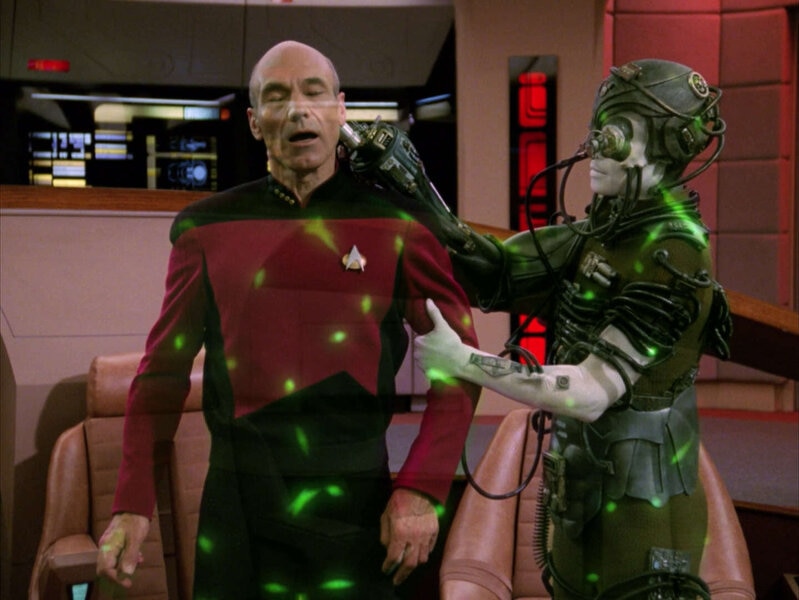
The Borg abduct Picard. (Credit: CBS)
I know. Borg who don't want to assimilate? You're thinking I'm crazy, or that I should at least double-check Memory Alpha.
But just for a minute, let's make something pretty clear: "The Best of Both Worlds" is the second appearance of the Borg in The Next Generation , following the species' debut in "Q Who?" just one season earlier, and in that first episode, the Borg do not mention wanting to "assimilate" anybody. Compared to what viewers first learned about the Borg in "Q Who?" their sophomore appearance offers a super-fast and full-on retcon that redefines how the Borg operate. When, in "The Best of Both Worlds," the Borg ship specifically asks for Captain Picard to hand himself over, Commander Shelby (Elizabeth Dennehy) — the visiting expert on the Borg — is incredulous. Here's how the scene plays out.
Shelby: "I thought they weren't interested in human lifeforms, only our technology."
Picard: "Their priorities seem to have changed."
Cue record-scratch! Because we have seen so many subsequent episodes and movies in which the Borg's default setting is to assimilate people and turn them into other Borg, this is hard to hear, but it's true. As established in the first Borg episode, "Q Who?," the Borg were not a cyborg species that assimilated other organic life. They just tried to harvest our tech. Q himself called the Borg "the ultimate user," and also cited the fact that the Borg didn't care about human life. Guinan's explanation as to how the Borg "scattered" her people throughout the galaxy was also vague and did not mention anything about being turned into Borg drones.
So, when it came time for "The Best of Both Worlds," TNG hastily rewrote the concept of the Borg — and later iterations of Trek really just hoped you didn't notice. This retcon was utterly successful by the way, because if it wasn't, then the existence of Seven of Nine and literally dozens of other characters and storylines barely make sense.
But let's back up. If the Borg's original purpose wasn't to assimilate biological beings, then how did they make other Borg? In "Q Who?" the Enterprise encounters a Borg ship and Riker and the away team learn that the Borg actually have little Borg babies, and those babies are given cybernetic augmentation as soon as they are born. In 1988's "Q Who?" the concept of the Borg creating more Borg through the process of cybernetic conversation ("assimilation") simply hadn't been written yet. Attentive audiences in 1990 might have been understandably confused if the Borg had done away with those Borg babies in favor of assimilation without Picard's throwaway line explaining the change.
Respectively, the episodes "Q Who?" and "The Best of Both Worlds" take place in the years 2365 and 2366. If you were to take Picard and Shelby's exchange at face value, then the Borg started assimilating people in 2366. But we know that's not true. Or, more accurately, we learned that wasn't true later.
Star Trek: Voyager established that Annika Hansen — aka Seven of Nine — was assimilated into the Borg Collective 10 years prior in 2356. And even with this fact, there's a small wrinkle. By the Voyager era, we learn about something called a "maturation chamber," which is where Borg put non-adults in stasis until they can be fully assimilated. This detail could reconcile the Borg babies from "Q Who?" and the apparent lack of assimilation in 2365, versus the let's-assimilate-everyone fest from that point on.
In other words, Star Trek canon retroactively makes it seem like the Borg have always assimilated organic lifeforms, and that the Enterprise was just confused about the Borg babies in "Q Who?" and, apparently, the Borg just didn't feel like assimilating any humans that particular day.
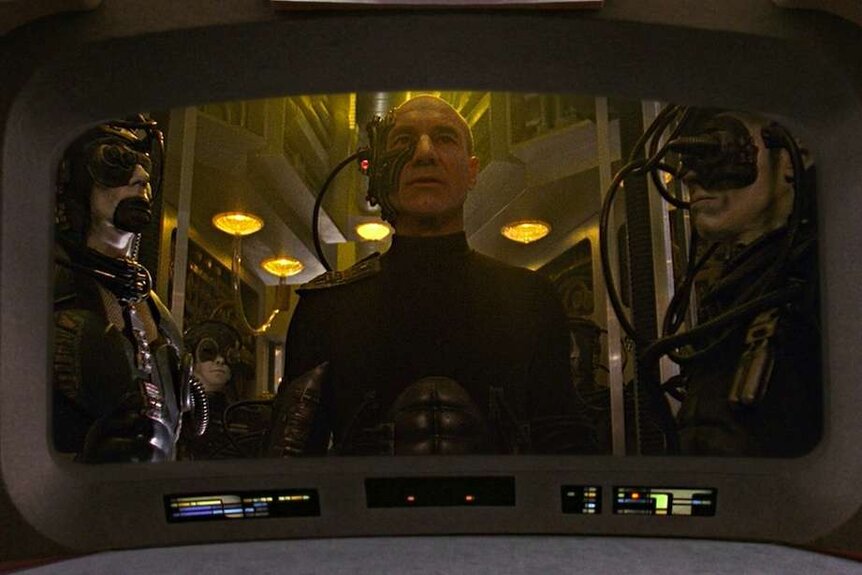
Picard zombified by the Borg. (Credit: CBS)
The looming threat of the Borg had been baked into the canon of TNG since the very beginning. In the Season 1 finale, "The Neutral Zone," the notion that a mysterious alien species was taking big scoops out of planets was mentioned, and in "Q Who?," Data affirms that the planet-scooping effect seems to have been the work of the Borg. At that time, writer and de facto showrunner Maurice Hurley intended for the Borg to be introduced much earlier, and possibly as an insect race. Hurley was also the writer of "Q Who?" and the person who, basically, created the Borg. Again, at this point, the scariest thing about the Borg was their hivemind and their planet-scooping abilities.
However, by the time TNG entered its third season, the writing staff had changed significantly. "The Best of Both Worlds Part 1" was written by Michael Piller, the TNG producer and writer who is largely credited with taking the series in a more character-driven direction. Essentially, Piller took the basic concept of the Borg and added a new layer: assimilation. His motivation seemed to be to create personal stakes for Picard and the crew. This single decision made the Borg much scarier, and also more versatile than they had been before.
In terms of what we saw on screen, the Borg were not cyborg zombies in "Q Who?," but after "The Best of Both Worlds," they were totally cyborg zombies. And the cleverness of this retcon is that it made it seem like that's how things had been all along. Resistance to retcon is futile.
Related Stories

Flushed Away Director On Aardman's First CG-Animated Feature

Anthony Mackie On John Doe Vs. Sam Wilson

Bruce Almighty Teleprompter Scene Wasn't in Original Script

The Fast and the Furious: Remembering how the Fast Saga began

The Definitive Guide to The Munsters Adaptations

Remembering Evolution, David Duchovny's Wild 2001 Sci-fi Film

The Hunger Games Timeline, Briefly Explained

Winnie-The-Pooh: Blood and Honey Creators Tease Shared Universe

All of The Leprechaun Movies, Ranked

Eternal Sunshine Director Made Wild Request of Jim Carrey Ahead Of the Film's Shoot

Back to the Future Easter Eggs You Almost Certainly Never Saw Revealed

John Carpenter's The Thing: Definitive Oral History
Recommended for you.

Linda Hamilton on Resident Alien Role: "I'm Not the Funny Girl, I'm the Straight Man"

The Classic Twilight Zone Episode That Inspired Jordan Peele's Us

Resident Alien's Alan Tudyk on Harry's New Love Interest, Edi Patterson's Blue Avian
- Celebrities
- Secret Invasion
- The Marvels
- Disney Plus
- Apple TV Plus
- Dwayne Johnson
- Brie Larson
- Ryan Reynolds
- The Witcher
- About & Advertising
- Privacy Policy
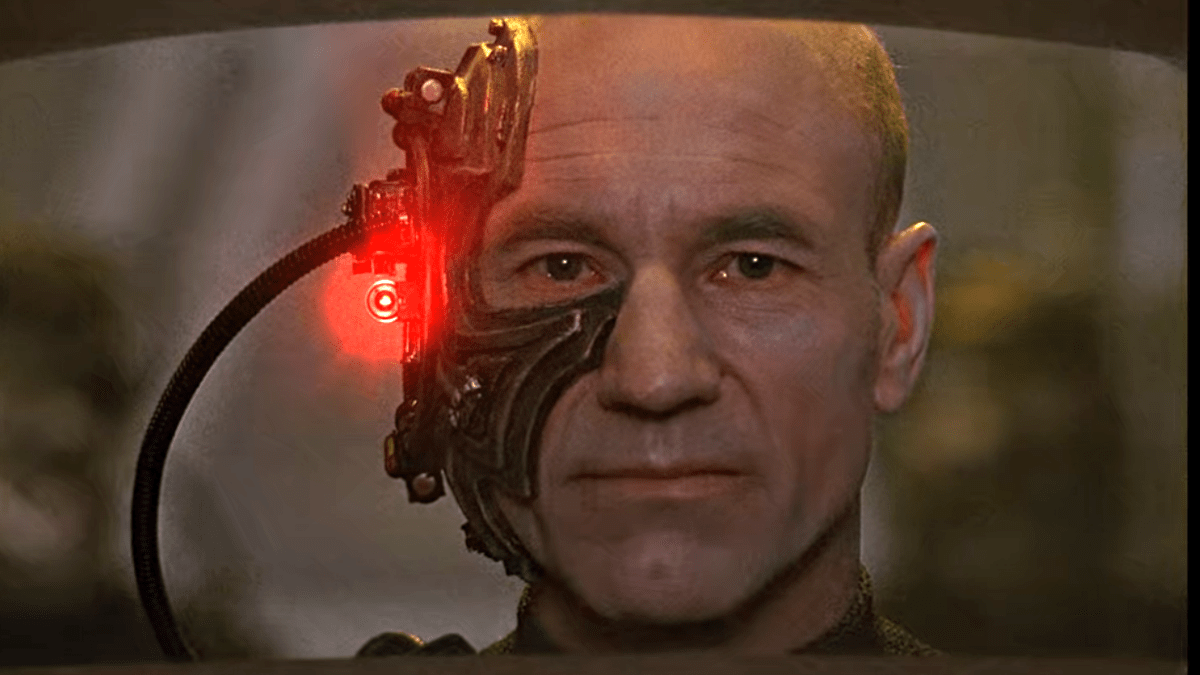
The Borg in ‘Star Trek,’ explained
Described by Captain Jean-Luc Picard as “ utterly without mercy ,” and “driven by one will alone: the will to conquer,” the Borg are a cybernetic hivemind with devastating technological superiority to the Federation, and one of the most feared factions in all of Star Trek . Their goal is to “assimilate” other races and civilizations into their own Borg Collective, and in doing so attain “perfection.” Picard concluded that any Borg Drone still connected to the Collective was “beyond redemption, beyond reason.”
Early encounters
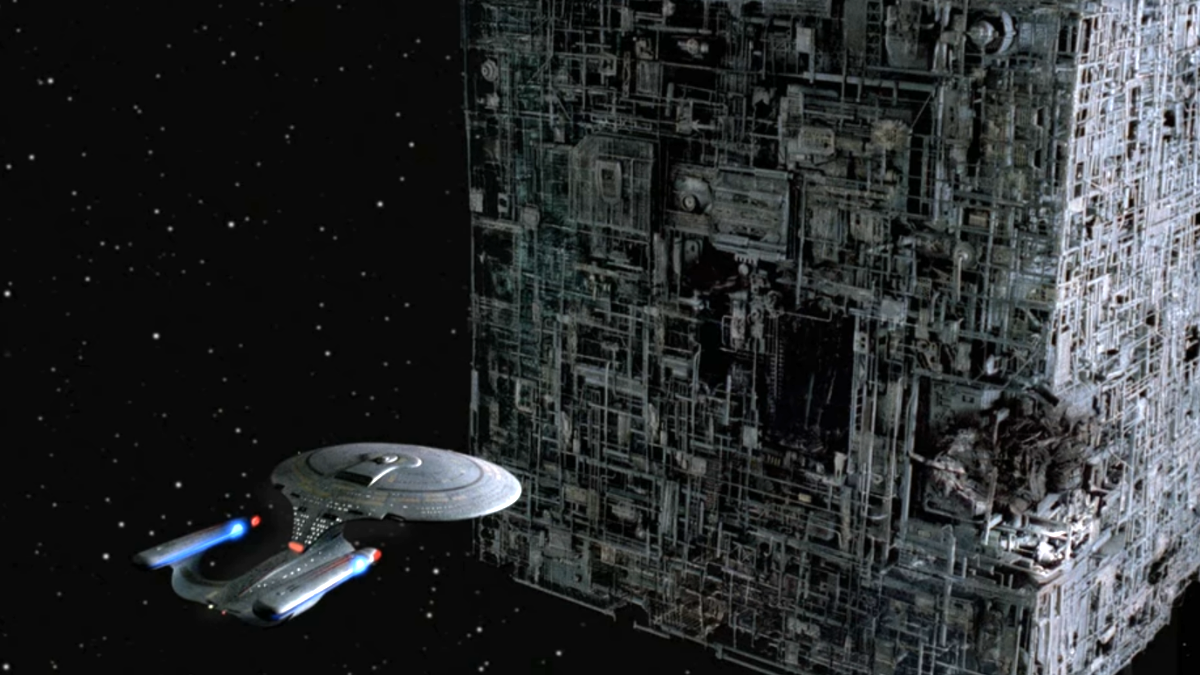
First introduced in the season 2 Next Generation episode “Q Who?,” the Borg’s initial encounter with Starfleet was terrifying. The Enterprise, under Captain Jean-Luc Picard, was thrown into the Delta Quadrant of the galaxy by the powerful being known as Q. Here, they encountered Borg Cubes, giant cube-shaped ships. All attempts at peaceful communication failed, and the Enterprise crew watched helplessly as part of the ship’s hull was cut away and taken over to the Cube, resulting in the loss of eighteen crewmembers.
The Enterprise’s best efforts to resist were fruitless. A boarding party led by Commander William Riker was able to enter the Cube on foot, but the horrors they saw forced them to retreat. The situation became dire, and the Enterprise was only saved when Picard begged Q for mercy, who agreed and returned the ship to its home quadrant.
But the Borg, having now encountered a Federation vessel, set their sights on Earth. A full-scale invasion was soon launched, during which the Borg carved through some of Starfleet’s best ships at the infamous Battle of Wolf-359, in which a single Cube destroyed 39 starships, resulting in the loss of approximately 11,000 lives (one of whom was Jennifer Sisko, wife of future Deep Space Nine Commander Benjamin Sisko). During the invasion, Picard was abducted by Borg drones and assimilated into the Borg Collective.
The invasion was narrowly thwarted only by the quick thinking of the android Data, who was able to turn the Borg’s assimilation of Picard against them by using him to send a command which neutralized the Cube. Picard would physically recover, but go on to have lifelong PTSD from the experience.

Moral dilemmas
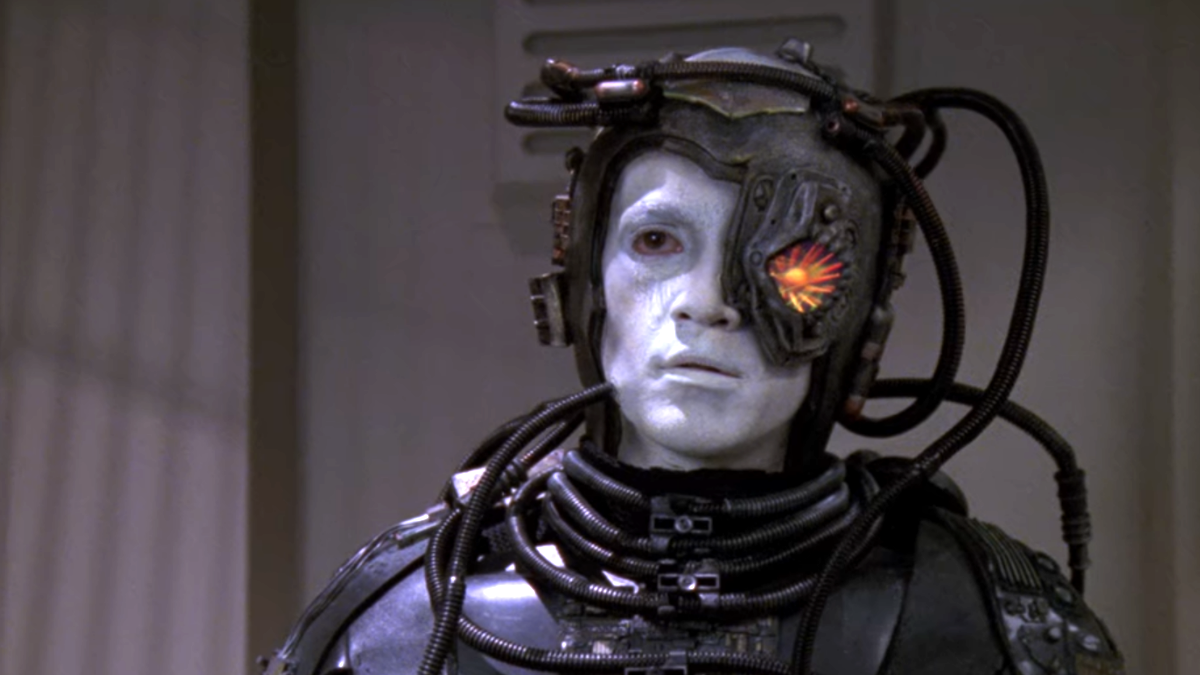
For a time after this, the Borg made no reappearance in the Alpha Quadrant until some years later the Enterprise again encountered the Collective, discovering a crashed Borg ship surrounded by dead drones with only one survivor. Picard ordered that the drone be brought aboard the Enterprise, and that research begin into a way to use the drone as a living weapon so that he could be returned to the Borg fleet with a virus that would destroy them all.
Several of the Enterprise crew ordered to work on the mission began to doubt the ethics of their assignment, especially when the drone began to exhibit signs of sentience and independence after being severed from the Collective. Picard’s past experience with the Borg made him hardened against these objections, but the interjection of his trusted friend Guinan – herself a victim of the Borg – forced him to reconsider. It was determined that the drone, named Hugh by the crew, was now an independent lifeform and that the original plan could not go ahead. Hugh ultimately volunteered to sacrifice himself by returning to the Collective in order to protect the Enterprise.
The Borg would be encountered once or twice more, but largely remained at home in the Delta Quadrant, where they were an immense force. In the year 2371, the USS Voyager , commanded by Captain Kathryn Janeway , was unexpectedly thrown 70,000 lightyears away into the Delta Quadrant during its very first mission. Despite the danger posed by the Borg and the impossibility of ever getting home, Janeway decided to voluntarily strand Voyager and its crew in this distant region of space in order to save a helpless alien species from destruction. Voyager thus began its journey home , which would eventually take them deep into Borg space.
Voyager’s saga
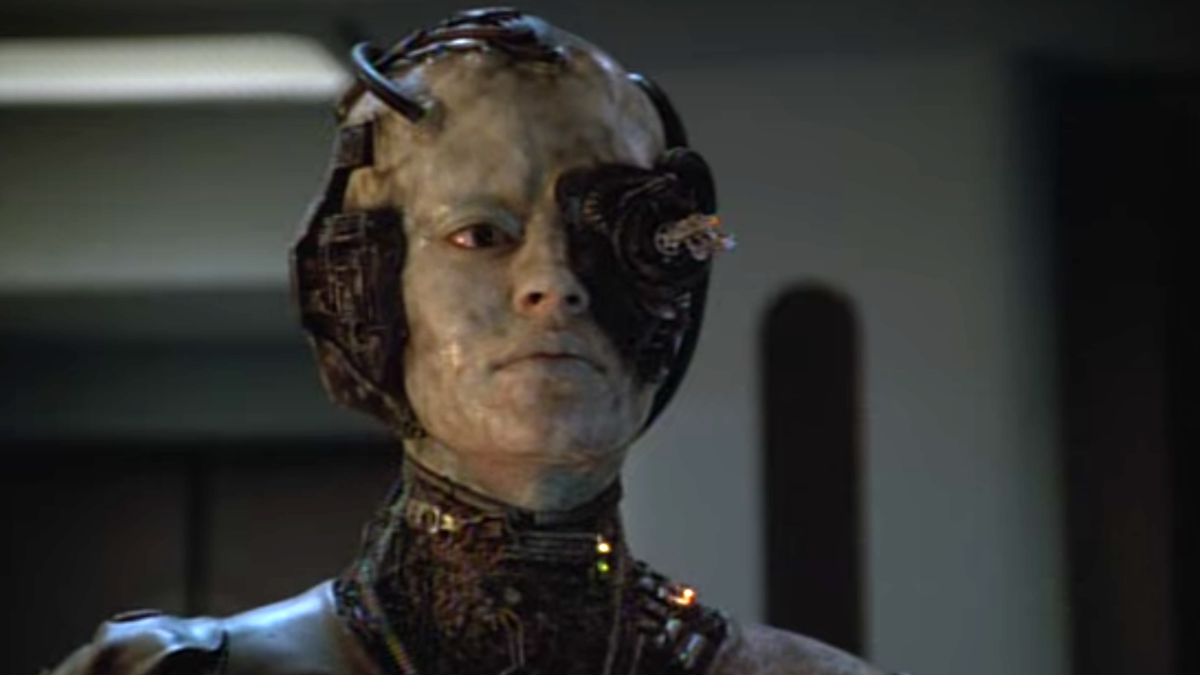
After some terrifying initial encounters, Voyager eventually fully entered Borg space. The Borg, however, were already at war: Species 8472 , a near-immortal alien species from a completely separate region of space, were invading Borg space and proving more than a match. As it seemed the only way through, Janeway made the incredibly high-risk decision to forge a temporary alliance with the Borg, with the full expectation of being betrayed. When this betrayal came, Voyager was ready, and managed to extricate itself from the battleground. One Borg drone, who had been sent to oversee the alliance, was left behind on Voyager during the confusion. Severed from the Collective, she began to redevelop her personality just as Hugh had, and took the name Seven of Nine .
Seven proved invaluable during Voyager’s subsequent skirmishes with the Borg, her knowledge of their technology and tactics allowing the crew to remain one step ahead of the omnipresent Borg threat. During their adventures, the Voyager crew came to realize that the Borg may not be “beyond redemption,” as Picard had believed, and that de-assimilation was in some cases possible. The crew were even able to liberate a small group of children who had been assimilated.
Around this time, the Borg attempted another invasion of Earth, this time by rewriting Earth’s history. The invasion was once again thwarted by the Enterprise, who followed the Borg to the past to ensure that history would remain unaltered. During this, the crew encountered the Borg’s apparent leader, named the Borg Queen.
Final defeat and future of the Borg
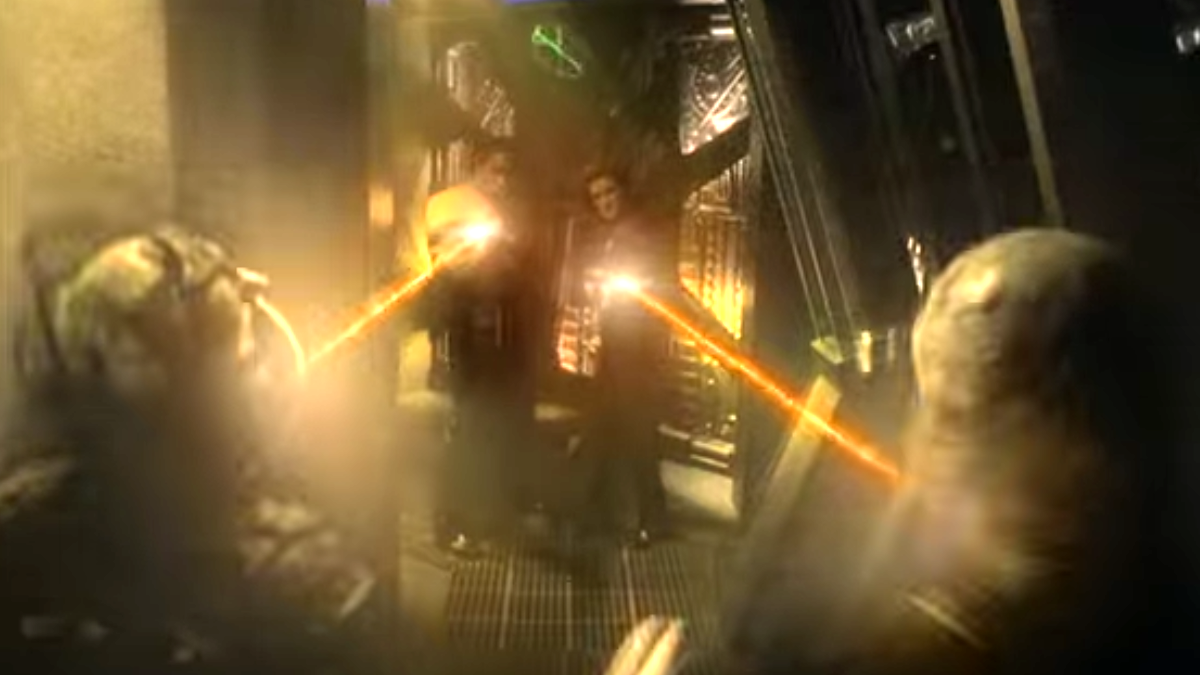
Later, Voyager was offered an unexpected shortcut home – another Kathryn Janeway arrived from decades into the future. Her plan was to allow herself to be assimilated, as she carried a custom-made neurolytic pathogen in her blood. Upon assimilation, the virus caused anarchy among the Borg drones, while Voyager hijacked the Borg’s transportation network to shoot themselves home. In the process, the hub was destroyed in an explosive chain reaction, cutting the Borg off from the Alpha Quadrant and stranding them 70,000 light years from Earth.
But the saga did not end with the heroic exploits of Janeway and her crew. Star Trek: Picard ‘s third season saw the Borg return with a vengeance. This time, under the direction of the Borg Queen, their plan was more subtle. They sought to covertly assimilate all younger Starfleet personnel at once, and have them turn on their older colleagues. Fortunately, Picard and his old Next Gen shipmates were unaffected. They managed to steal the Enterprise-D (by then sitting as a relic in a fleet museum), and foil her sadistic plan.
An enemy as well-crafted as the Borg will always have a chance of returning in future iterations of Trek . As a hive mind, they appeared to be a monster of unspeakable menace. Yet, as episodes like “ I Borg ” and “ Survival Instinct ” showed, inside each drone was an individual screaming to get out. This left Captains who confronted the Borg with a serious moral dilemma, and a level of nuance which future writers would do well to explore.
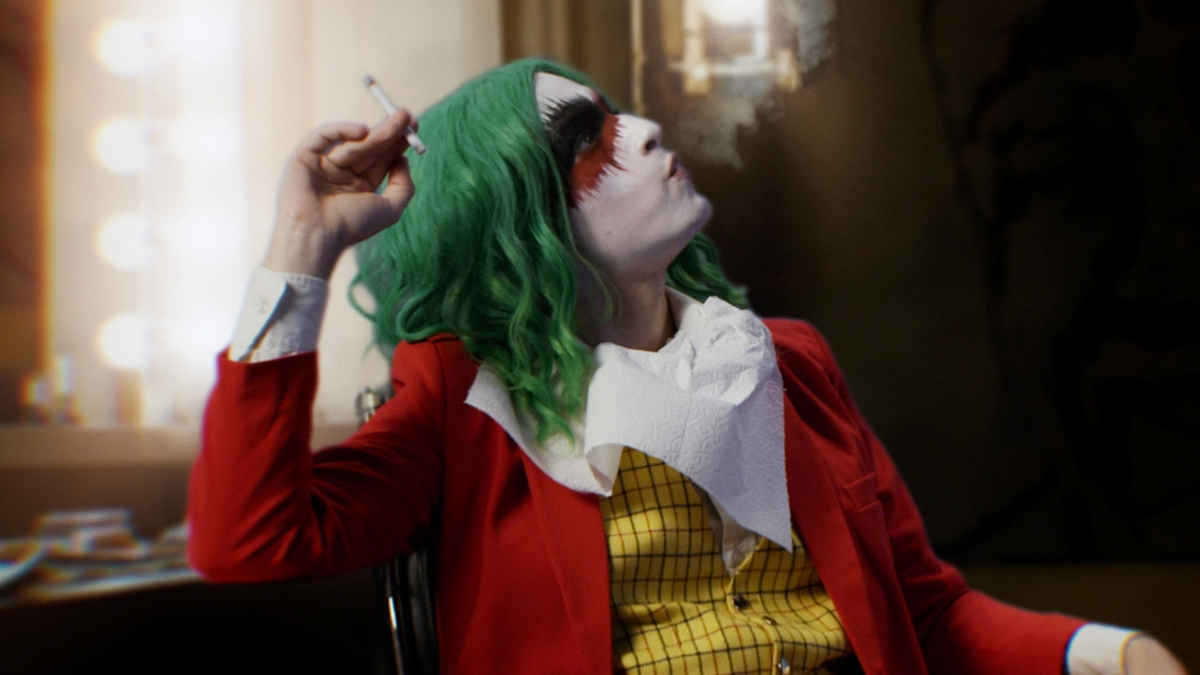
- More to Explore
- Series & Movies
Published Aug 25, 2018
Are We Borg?
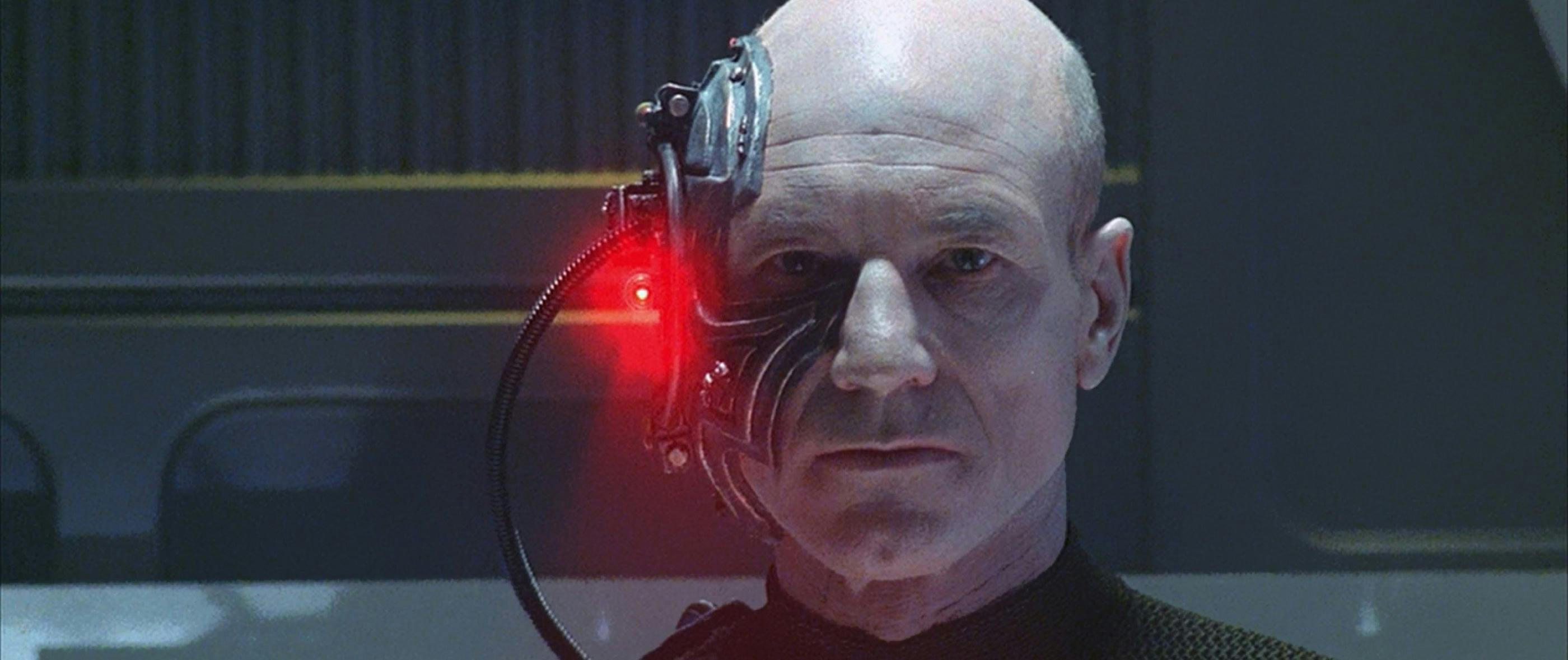
“I am Locutus, of Borg. Resistance... is futile. Your life as it has been is over.” Spoken by Captain Picard on the season-three finale of Star Trek: Next Generation , this has to be one of the most-chilling bits of dialogue in the entire Star Trek canon. It’s not just Patrick Stewart’s cold-blooded delivery, but also the image that accompanies it. Picard has been modified. His head has been augmented with Borg technology, a cortical processor has been implanted in his brain and a laser scope is mounted below his right eye. A cable circulating hydraulic nano-fluids runs from his motorized right arm into his skull.
We are deeply fascinated and unsettled by this man who is no longer wholly human. Like Frankenstein’s monster Picard has been remade in a laboratory, his body hacked, drilled and resectioned. It’s fuel for our nightmares. Yet we live in a world where medical technology and freedom of aesthetic choice make implants and body modification possible, even commonplace.
When we can have acrylic rings inserted into our corneas to correct nearsightedness, defibrillators embedded in our chests to shock an arresting heart, and sacks of silicone implanted in our buttocks to create Kim Kardashian curves, why does Locutus disquiet us?
Aren’t we, like him, Borg?
Last week, I spent three hours in a dental chair while an oral surgeon implanted a titanium rod in my jaw. It’s a screw-like post that forms the base of a dental implant. I was so taken with the X-ray I asked the surgeon to email me a copy. Here in black and white is proof I am now a cyborg. Part human, part mechanical device. What you can’t see on the X-ray is the xenotransplant. Living tissue from a non-human species (bovine bone) has been packed around the implant where, over time, it will be integrated into my natural bone.
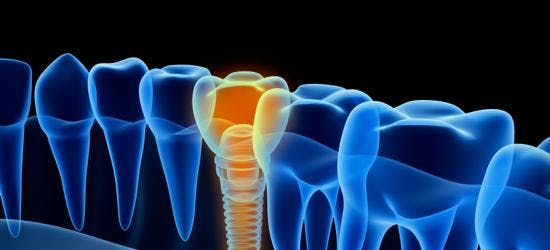
Assimilating a foreign species, technology embedded in my jaw: Am I Borg?
It’s estimated that as many as five million Americans are implanted with medical devices each year. The most-popular procedure is almost exclusively performed on children: a myringotomy where a polymer tube is inserted into the eardrum to prevent buildup of fluid in the inner ear. Nearly a million kids a year have this done. Yet we recoil when we see a Borg maturation chamber ( Star Trek: Voyager ) containing an infant augmented with cochlear implants.
Why? What’s the difference between our implant technology and the Borg’s? Is augmenting our bodies only acceptable when there is a medical need, such as a recurring ear infection or heart arrhythmia? What about procedures we elect to undergo for aesthetics? Breast augmentation, chin augmentation, silicone six packs? Over 300,000 Americans underwent breast augmentations in 2017. Clearly, there is widespread acceptance and adoption of body modification for both medical and aesthetic reasons.
Could the difference be then that we consider it immoral to remove healthy organs and limbs and replace them with performance-enhancing technology? When we believe the Borg have removed Picard’s right arm and replaced it with a prosthetic equipped with a multi-functional tool, we are repulsed. This represents mutilation to us… but does it also represent our future?
DARPA is currently developing wearable mobile machines called exoskeletons which increase the strength and endurance of troops in battle. Elon Musk’s company Neuralink is creating a BMI (brain-machine interface) which can be implanted into the human brain to augment intelligence and create a “neural lace” network. Google has filed patent on a lens implant that requires drilling a hole through the eye’s natural lens in a procedure eerily similar to the one performed on Picard by the Borg in Star Trek: First Contact . When big companies put big money into mashups of healthy human tissue and high tech you can bet we haven’t heard the last of it.

The drive to integrate our biology with our technology is part of a movement called transhumanism. Transhumanists believe in pushing human capabilities beyond their natural limits. Superior bodies, superior minds and immortality are the ultimate goals.
Borg are the living definition of transhuman. Their augmented bodies give them incredible physical strength. Their neural processors and collective “hive mind” give them a computational power beyond our understanding. And immortality? In Star Trek: Voyager , Seven of Nine, a former Borg, tells us, “When a drone is damaged beyond repair, it is discarded. But its memories continue to exist in the collective consciousness. To use a human term, the Borg are immortal.”
Is this why we feel both horror and fascination when we first see Locutus on the Borg cube? Do we recognize the Borg as an allegory for our future selves? If we continue to embrace technology and push the boundaries of what it means to be human will we evolve into drones who use their technology for one purpose: to acquire more technology?
The Borg, in their singular pursuit of technology, have lost appreciation for human beauty. Their bodies are enhanced solely for function. Could this be the real reason they repel us? Utilitarian black hoses plugged into necks, a scrapper’s yard of body hacks, hands a virtual toolbox of pincers and cogs? Neither slick nor pretty, the Borg are the embodiment of anti-aesthetic… which just might be the most alien thing about them. After all, haven’t we always hoped the future would be beautiful?
To learn more about this subject, please visit www.LearningForASmallWorld.com . The course " Star Trek : Inspiring Culture and Technology ” provides greater depth on this and many more aspects of the history and impact of Star Trek .
J.V. Jones is a USA Today bestselling writer whose acclaimed Sword of Shadows series is published by Tor Books.
Get Updates By Email

Star Trek Confirms the Borg Are Immune to a Major Galactic Threat
- The Borg are immune to parasitic aliens in Star Trek: Defiant #13, sparking fan shock & speculation.
- It is an encounter of two major villains: the parasites from "Conspiracy" vs. Borg, and it makes for an epic showdown.
- Future Star Trek: Defiant issues hint that Borg nano-probes are a solution to the crisis. The Borg immunity may save the galaxy.
Warning: contains spoilers for Star Trek: Defiant #13!
Star Trek has confirmed the Borg are immune to a major new galactic threat. The parasitic aliens from the first season Star Trek: The Next Generation episode “Conspiracy” have returned, primed for a takeover of the Federation. Yet, in Star Trek: Defiant #13, the parasites try to bond themselves with Worf and his crew–and fans are shocked to learn the Borg are seemingly immune.
Star Trek: Defiant #13 is written by Christopher Cantwell and drawn by Angel Unzueta. Worf and the Defiant’s crew have docked at Starbase 99, which has been infested with parasitic aliens. The parasites then attack, and as Worf and company try to fend them off, one of the aliens attempts to take over Hugh, the ex-Borg drone that recently joined the crew. However, they are unable to do so, calling the Borg “corrupt tissue” that is of no use to the parasites.
Hugh cracks a joke, saying the rejection makes him “sad.”
Two of Star Trek's Biggest Villains Have Collided
An encounter will that inspire fan conversations.
The brief exchange between the aliens and Hugh is a meeting of two of the biggest threats to the Star Trek universe. The parasitic aliens from “Conspiracy” have finally returned, following up on the promise of their sole on-screen appearance. The episode ends with the aliens sending some sort of signal into deep space, with the implication it was a beacon, signaling for an invasion. It took the parasites some time to make their way back to our galaxy, but now they have returned and are deadlier than ever.
However, their goals of conquest have already hit a major stumbling block: the Borg. The parasites made a remark about Hugh’s tissue being dead and thus useless, a clear reference to the nano-probes the Borg use to assimilate others. As the assimilation process takes hold, living tissue is significantly altered, and apparently so much so that it renders the body useless to the parasites. What is ironic about this is that Star Trek: Defiant #13 draws a number of parallels in the societal structures of both the Borg and the parasitic aliens.
Star Trek's 2009 Movie Hid the Full Power of Nero's Ship (& Its Borg Connection)
Who would win: the parasites or the borg, it would be an epic star trek showdown.
Yet despite these similarities, the parasite aliens and the Borg are fundamentally incompatible. Both species are driven by the need to bring all life forms under their control, but take different routes for doing so. By assimilating, or taking over, other lifeforms, the two species expand their knowledge base. If a parasite cannot take over a Borg, they cannot defeat them. Solicitations for future issues of Star Trek: Defiant have revealed Borg nano-probes may be the only solution to the crisis. The Borg’s immunity to the parasites may be the galaxy’s saving grace.
Star Trek: Defiant #13 is on sale now from IDW Publishing!
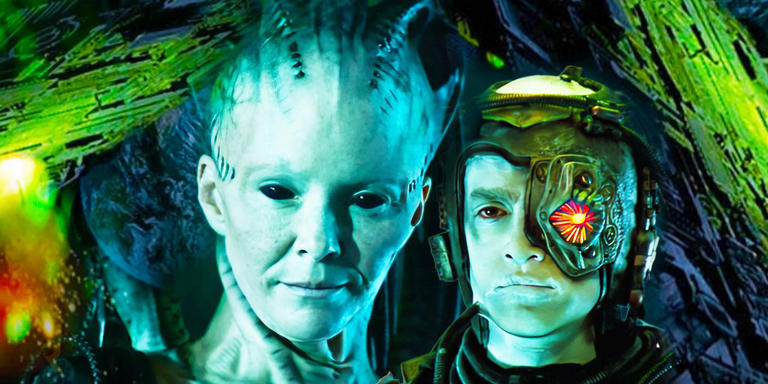

- View history
The Borg Queen was the name of the entity that existed within and served as the queen of the Borg Collective . An ancient being, the Queen has existed for many hundreds of years. ( Star Trek: First Contact ; PIC : " Surrender ") In the event of her body's destruction, she would appear to be reincarnated with her personality and memories intact. ( Star Trek: First Contact ; VOY : " Dark Frontier ", " Unimatrix Zero ", " Unimatrix Zero, Part II ", " Endgame ")
Two decades after suffering catastrophic defeat at the hands of Admiral Janeway , the Borg Queen collaborated with a rogue faction of Changelings to rebuild her collective and take revenge upon the Federation . Her final scheme was thwarted by her old enemy, Jean-Luc Picard , and she was killed once and for all by the USS Enterprise -D , bringing an end to the threat of the Borg. ( PIC : " Võx ", " The Last Generation ")
- 1 Role and personality
- 2.2 Attacks on Earth
- 2.3 Conflicts with Voyager
- 2.4 Alliance with the Changelings
- 3 Alternate timeline
- 5.1 Appearances
- 5.2 Background information
- 5.3.1 Borg Invasion 4D
- 5.4 External links
Role and personality [ ]
The Queen defined herself as: " I am the beginning, the end, the one who is many. I am the Borg. " As the queen of the Borg Collective and the lone individual within it, the Borg Queen provided direction and purpose for the hive mind. ( Star Trek: First Contact ; VOY : " Unimatrix Zero ", " Unimatrix Zero, Part II ", " Endgame "; PIC : " Watcher ", " Hide and Seek ")
It was thought by Federation exobiologist Erin Hansen that the Borg Queen functioned like the queen of an insect hive, to coordinate the drones. Evidence of this was later seen when the Queen countermanded the Collective's judgment about assimilating Voyager in 2378 . While the Collective felt that assimilation was warranted, the Borg Queen countermanded them and justified the decision due to the fact that Voyager didn't compromise their security. ( VOY : " Endgame ")
The Queen, while providing coordination for the drones she commanded, also provided other functions such as regulation of the Collective's transwarp hubs and interspatial manifolds . She effectively brought "order to chaos" for all things. ( VOY : " Endgame ")
According to Seven of Nine , " The Borg Queen has a kind of trans-temporal awareness. It bridges into adjacent times, realities. They hear echoes of themselves, of— of each other. " ( PIC : " Penance ")
The death of the Borg Queen, while traumatic to drones in the immediate vicinity, did not seem to permanently affect the Collective or its hive mind as a whole. The Queen was subsequently replicated after each death, although the exact mechanism of her reincarnations remains unclear. Borg drones were capable of functioning without a Queen for any length of time by forming a Hive mind of their own. ( Star Trek: First Contact ; VOY : " Unity ", " Dark Frontier ")

The disembodied Borg Queen aboard the partially-assimilated Enterprise -E
In accordance with the Borg pursuit of perfection, a blending of the organic and synthetic, very little of her original humanoid form remained. Her face and upper torso were organic while the rest of her body, including her skull and spinal cord , were synthetic . Because of her disembodiment she saw herself as the epitome of perfection. The Queen had her own chambers within the Borg Unicomplex from which she could oversee and control the Borg via the command interface . Whether she had her own ship or not is unknown, but she used different Borg vessels to travel, such as a Borg cube , sphere , or octahedron . When her physical presence was not necessary her organic part resided above this chamber while her synthetic parts were stored below it, under the floor. If she desired to do so, both could be brought together, and in doing so, created a humanoid form for herself.
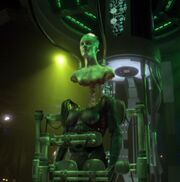
The Borg Queen assembled in 2377
Where her drones showed no emotions , the Queen herself did. She was ruthless, vindictive, petty, and selfish. She would do anything to expand the Borg Collective, employing psychological tactics like extortion, manipulation, plain intimidation or even seduction to further her goals. The Queen placed her own self-preservation over that of the Collective, cannibalizing the bodies of her last remaining drones to keep herself alive after the collapse of the hive. On a personal level, she considered Seven of Nine her favorite drone, because the Queen considered her to be unique. ( VOY : " Unimatrix Zero ", " Dark Frontier ")
Despite being one with the minds of billions, the Queen felt a sense of profound isolation and loneliness. Her inexorable drive to assimilate was partially motivated by a desire for connection. With millions of species not enough to sate her, she attempted to fill this void by grooming potential counterparts that were more than mere drones. Jean-Luc Picard , Data , Seven of Nine , Agnes Jurati were all such candidates. ( Star Trek: First Contact ; VOY : " Dark Frontier "; PIC : " Hide and Seek ")
Following the decimation of the Borg Collective, the Borg Queen succumbed to desperation and insanity from the isolation she endured. Nevertheless, she retained her intellect and tactical mind, working with the Changelings from behind the scenes to execute her plans for a Borg resurgence. ( PIC : " Võx ", " The Last Generation ")
History [ ]
The Borg Queen (or perhaps merely one of her bodies) was assimilated to the Collective from Species 125 around the age of 7-8, along with her parents, and was already active in the Delta Quadrant in 2354 . ( VOY : " Unimatrix Zero, Part II ")
Attacks on Earth [ ]
The existence of the Borg Queen was documented sometime prior to 2365 by the exobiologists Erin and Magnus Hansen . However, because the Hansens were assimilated, their discovery never reached the Federation . ( VOY : " The Raven ")
It was not until 2373 , that the Federation became aware of her when the Federation starship USS Enterprise -E prevented the assimilation of Earth . This was the second attempt by the Borg, also known as the Battle of Sector 001 . The Borg Queen, along with a contingent of drones, traveled back to Earth's past to prevent First Contact , and by doing so, hoped to be able to assimilate Earth.

The Borg Queen with Locutus in 2366
During this conflict, while Captain Jean-Luc Picard was trying to destroy the Borg, the Queen claimed to have been present during the Battle of Wolf 359 , and even admitted that Locutus of Borg – the assimilated Picard – was intended to be a singular intelligence – a counterpart that was intended to ease the burden of loneliness. However, when Picard continued to resist, even when he could not control Locutus' body, she was regretfully forced to turn him into the form in which Starfleet encountered him—a glorified drone. Whether or not she physically took part in the Battle of Wolf 359 was unknown.
Picard and Data killed the Borg Queen after she tried to persuade Data to give her the encryption code by which he had locked the Enterprise 's computer . She ordered Data to destroy the Phoenix spaceship with quantum torpedoes, and taunted Picard that she would rule Earth without Humans or the Federation in it, when the torpedoes missed. Data told her, "Resistance is futile!" and vented the warp core plasma coolant , which destroyed her organic parts. Picard then broke her cybernetic spinal cord, which ensured that she could no longer function. ( Star Trek: First Contact )
In 2399 , Picard mentally recalled the image of the Borg Queen and Locutus while aboard The Artifact . ( PIC : " The Impossible Box ")
As of 2401 , the remains of this incarnation of the Queen were stored at Daystrom Station . ( PIC : " The Bounty ")
Conflicts with Voyager [ ]
Starfleet's second documented encounter with the Borg Queen was in 2375 in the Delta Quadrant . Here, the lost Federation starship USS Voyager, tried to rescue the former Borg Drone, Seven of Nine, who was then part of Voyager 's crew, when the plan to steal a transwarp coil from a Borg sphere did not work out as planned. The Queen also revealed that Seven of Nine was not really freed by Voyager from the Collective, but was allowed to leave by the Borg. During this encounter, the Borg Queen hoped to assimilate Seven of Nine again, who experienced life as an individual for two years, and by doing so, add to her own perfection. However, Seven rejected the Queen and fled with a rescue mission sent by Voyager in the Delta Flyer . The Borg Queen's octahedron was sent by the Queen to intercept the shuttle , but it was destroyed in the attempt. ( VOY : " Dark Frontier ")
The Borg Queen was one of several real people who was adapted into a character in Kelis ' play, based on descriptions from B'Elanna Torres . ( VOY : " Muse ")
In 2376 and 2377 , the Borg Queen was again encountered by Voyager . This time the Queen wanted to destroy Unimatrix Zero , a virtual world that was populated by regenerating Borg with a genetic mutation. This world was discovered by Seven of Nine and posed a threat to the Borg. During Voyager 's efforts to rescue this virtual world, the Borg Queen demonstrated her powers by destroying a Borg sphere because she could no longer "hear" only one drone. When a nanovirus was released to prevent the detection of Unimatrix Zero , the Queen destroyed several Borg vessels, and killed 75,000 Borg Drones in the process, in the hope of persuading the captured Captain Janeway to give her the antidote. ( VOY : " Unimatrix Zero ", " Unimatrix Zero, Part II ")
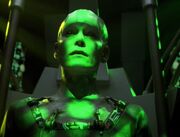
The Borg Queen in 2378
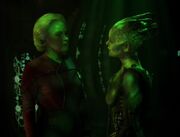
Admiral Janeway confronts the Borg Queen in 2378
The last encounter between Voyager and the Borg Queen was in 2378 . Voyager accidentally discovered a Borg transwarp hub within a nebula and were helped by Admiral Kathryn Janeway, who came from an alternate timeline around twenty-six years in the future , to use the Borg transwarp network to get back to the Alpha Quadrant . Because the Borg guarded their transwarp hub closely, Admiral Janeway devised a plan by which she would infect the Borg Queen with a neurolytic pathogen and in doing so make her lose control over the force fields which protected the interspatial manifolds. When the admiral was captured by the Borg, near the Unicomplex , she was assimilated by the Borg Queen herself. Soon after, the Queen began to lose control over her drones.
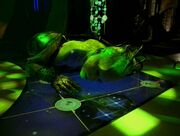
The end of the Borg Queen
The pathogen even made her lose control over her own synthetic parts, as her body literally fell apart. Her death caused the destruction of the Unicomplex and despite her efforts, Voyager reached Earth safely. The Borg sphere that was sent after them by the Queen was destroyed by Voyager 's transphasic torpedoes , which were given to them by Admiral Janeway from the future. ( VOY : " Endgame ")
Alliance with the Changelings [ ]
Despite the peace brokered between Jurati's Borg and Starfleet, the original Collective remained hostile, and set in motion a plan to assimilate Starfleet from within. The Collective had slowly dwindled following the neurolytic pathogen infection from Admiral Janeway. The Queen managed to survive by cannibalizing parts of her drones, though without the ability to assimilate new drones into the Collective, the Queen was eventually left alone as her drones died of starvation and old age which apparently drove her insane.
As those voices fell silent, the Queen began to hear a new voice - that of Jack Crusher , the son of Jean-Luc Picard and carrier of a transmitter protein inherited from his father's Borg-altered DNA. She realized that the future of the Borg no longer lay in assimilation, but in evolution, propagation, and the annihilation of all other life forms in the galaxy. Over the years, the Queen communicated with Jack, intending to lure him to her. Jack believed the voice was that of his mother.
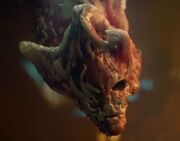
The Borg Queen communicating with Vadic as "The Face"
In order to enact her plan, the Borg Queen made a deal with rogue Changelings , lead by Vadic sometime leading up to 2401 . The Changelings, who were vengeful themselves for what had happened to them in the Dominion War, agreed to help by stealing Jean-Luc Picard's body from Daystrom Station in order to extract his Borg DNA and spread it through Starfleet's transporter system as common biology. They would also hunt Jack Crusher with the intent of bringing him to the Borg Queen. ( PIC : " The Last Generation ")
She communicated with Vadic via Vadic's severed hand , with which the Borg Queen formed a simulacrum of a face in mid-air.
Vadic reported that the USS Titan -A , carrying their "asset" Jack Crusher , had fallen into the gravity well at the center of the Ryton Nebula , where her ship the Shrike could not follow due to its portal weapon . The Borg Queen ordered Vadic to pursue regardless, stating that everything, including her and her crew, was expendable. ( PIC : " No Win Scenario ")
After capturing and interrogating William T. Riker and Deanna Troi but failing to gain any information, Vadic contacted the Borg Queen again to report that they would not break. The Borg Queen demanded that she try harder to break them, and noted that Vadic's physiology was not as special or complex as she believed. She stated that the Changelings' nature was to be malleable, while the enemy's kind were "beholden to a singular flesh." The Borg Queen then reiterated that Starfleet's fallure was near and she needed Jack Crusher, but warned that should Vadic fail, the Changelings' existence would become "meaningless." ( PIC : " Dominion ")
After Jack became aware of his true nature, he sought out the Borg Queen, with the intention of killing her. Arriving aboard her makeshift mega-cube in the atmosphere of Jupiter , the Queen welcomed Jack, telling him that she had "thought of so many names" for him – "Regenerati. Peur Dei." Jack rejected these names, and the Borg Queen responded that he was Võx, not Locutus, "the one that speaks". Jack was "the voice itself". Boarding the cube to confront her, Jack raised his phaser but was unable to kill the Borg Queen, who mocked him for his inability. She then assimilated Jack and used him to broadcast a signal to all affected Starfleet personnel, triggering the last stage of their assimilation. ( PIC : " Võx ")
The crew of the USS Enterprise -D tracked a Borg signal to Jupiter. Picard, William T. Riker and Worf beamed aboard the Borg vessel to find both Jack and the origin of the signal. Picard separated from Riker and Worf to find Jack, who had already been transformed completely into Võx .
Picard's confrontation with the Queen escalated until Picard reconnected with Jack and convinced Jack to reject the Borg. The Enterprise flew in overhead, and was able to beam them to safety as the Cube exploded from the Enterprise 's attack, killing the Queen and ending the Collective once and for all.
Following the Borg Queen's death and the destruction of her Cube, the signal to Starfleet was cut ending the Borg control over it. Dr. Beverly Crusher was subsequently able to find a way to remove the Borg DNA from everyone, ending the Borg Queen's plan permanently. ( PIC : " The Last Generation ")
Alternate timeline [ ]
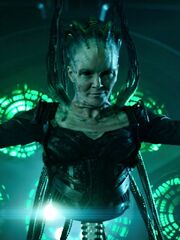
The Borg Queen from an alternate 2401
In 2401 , an atypical version of the Borg Queen beckoned Jean-Luc Picard to a region of space , where she expressed a desire to join the Federation. After it seemingly appeared to take over the USS Stargazer , Picard destroyed the ship, rather than to allow it to be assimilated.
Following the destruction of the Stargazer , Picard and other members of the Stargazer crew found themselves in an alternate timeline , created through the intervention of Q . Xenophobic Humans dominated parts of the galaxy, and even managed to defeat the Borg; their immobilized Queen was held by the Earth's Confederation. This Borg Queen, who possessed an awareness of the split in the timeline, was set to be executed by Picard. With her species having been wiped out in this timeline, the Borg Queen agreed to help Picard and his crew travel back in time and correct the timeline.
Though killed by a shotgun blast from Jurati, after arriving in 2024 , this Queen had managed to assimilate Dr. Agnes Jurati and live on through Jurati. ( PIC : " The Star Gazer ", " Penance ", " Mercy ", " Farewell ")
- See : Agnes Jurati, Borg Queen
Hologram [ ]
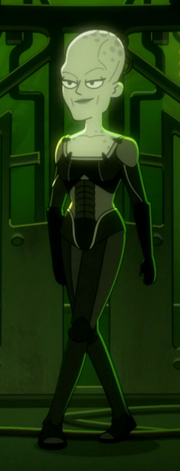
A hologram of the Borg Queen
A hologram of the Borg Queen appeared in Starfleet 's Borg Encounter holographic training drill , in use by 2381 . In the simulation , it was possible for the user to beat the Queen at chess and teach her empathy to improve their score. ( LD : " I, Excretus ")
Appendices [ ]
Appearances [ ].
- Star Trek: First Contact
- " Dark Frontier "
- " Unimatrix Zero "
- " Unimatrix Zero, Part II "
- " Endgame "
- " The Impossible Box " (archive footage)
- " The Star Gazer " (alternate timeline)
- " Penance " (alternate timeline)
- " Assimilation " (alternate timeline)
- " Watcher " (alternate timeline)
- " Fly Me to the Moon " (alternate timeline)
- " Two of One " ( illusion )
- " No Win Scenario " (as "The Face")
- " Dominion " (as "The Face")
- " The Last Generation "
- LD : " I, Excretus " (hologram)
Background information [ ]
The Borg Queen was played by Alice Krige in Star Trek: First Contact , VOY : " Endgame ", PIC : " Võx ", " The Last Generation " (voice only) and (as a holographic duplicate ) LD : " I, Excretus ". The character was played by Susanna Thompson in the Star Trek: Voyager episodes " Dark Frontier ", " Unimatrix Zero ", and " Unimatrix Zero, Part II ". In Star Trek: Picard season 2 , the Borg Queen was played by Annie Wersching . The Borg Queen's Changeling simulacrum, identified in end credits as "The Face", was voiced by Garth Kemp . The body of the Queen in season 3 of Picard was portrayed by Jane Edwina Seymour , credited as "Borg Queen Body Double ".
In an early design meeting for the Borg Queen, the movie Captain EO was mentioned, regarding Anjelica Huston 's performance as a villainous woman who lived in the ceiling and would descend on cables. [1]
The appearance of the Borg Queen in First Contact was a controversial one in the Star Trek universe. Though the Borg provided for a threatening and intriguing alien enemy, their lack of a single villain presented a challenge for the writers. To counter this, and to expand some on the original notion of the Borg as an insect-hive type of race, they created the Borg Queen as a focal point for their story. Writer Brannon Braga has stated in this respect, " I think some people liked the Borg Queen and some didn't, but to us the Borg Queen was the thing that made it all work. We realized very quickly that the Borg aren't that interesting for a feature film for two hours because they don't say anything. They're robot zombies. So, to me, the Borg Queen was the coolest new thing about that movie. " [2]
Later in First Contact , when asked by Picard how she had survived when the cube that was sent to Earth in 2367 was destroyed, the Queen only replied that Picard had become small, and thought in three-dimensional terms.
Alice Krige purposely limited the ways in which she prepared for "Endgame", reviewing neither her own work on First Contact nor any of Susanna Thompson's portrayal of the same character. This choice was not motivated out of any sort of disrespect for Thompson, and had nothing at all to do with the actress. ( Star Trek Magazine issue 169 , p. 52; [3] ) Krige speculated, " Whoever had played the role, I would have made the same decision. " [4] Explaining why she made the choice, Krige conceded, " I thought to see someone else's performance would throw me off course. It was already going to be fairly different because it was the Borg Queen with two females, as opposed to the Borg Queen with two males [...] I just felt it wouldn't help the process. " ( Star Trek Magazine issue 169 , p. 52) She also related, " I didn't want something in my head, in my imagination. I needed my performance to happen in the moment. " [5] Krige did, however, request to receive and read all the Voyager scripts featuring the Borg Queen, including the new teleplay for "Endgame". She indeed read the scripts, despite not watching any of the episodes. ( Star Trek Magazine issue 169 , p. 52; [6] )
In 2002, the Borg Queen was placed second in TV Zone 's list of the top twenty science fiction television villains. Dukat was fourth, Weyoun was eighth, Q was eleventh, and Seska was nineteenth. ( citation needed • edit ) In an early version of the script of Star Trek: First Contact (a script very different from the movie), Geordi La Forge tells Data that he is sending the Borg Queen's remains to the Daystrom Institute for study. [7]
When asked whether the Queen was a "virtual entity; the personification of the collective", Braga's writing partner, Ronald D. Moore , said, " This was not the intention. We saw her as a literal person. " ( AOL chat , 1997 )
According to Judith and Garfield Reeves-Stevens , they pitched a story for an episode of Star Trek: Enterprise where Alice Krige would play a Starfleet medical technician who made contact with the Borg from " Regeneration ". The encounter would have been the birth of the Borg Queen. [8]
An undersuit that was worn by Krige in First Contact was sold off as lot 9677 in the It's A Wrap! sale and auction on eBay.
The Borg Queen, Dimitri Valtane , Lojur , Admiral Hayes , B-4 , and the punk on the bus are the only characters to debut in a Star Trek film before appearing in a Star Trek television series.
Apocrypha [ ]
According to the Pocket VOY novel, The Farther Shore published after the television series concluded, a Borg Queen could be replaced in mere seconds by using the Royal Protocol. Seven of Nine was specifically mentioned in the Royal Protocol and was most likely to become the next Queen.
The Pocket TNG novel Resistance showed the creation of another Queen, who was destroyed by the crew of the Enterprise -E. Subsequently, in the Pocket TNG novel Before Dishonor , Admiral Janeway was assimilated by the Borg and became a Queen who was eventually defeated by Seven of Nine.
In the Star Trek: Destiny trilogy, a newly installed Queen oversaw a massive Borg invasion of the Alpha Quadrant. It was later revealed that the Borg Queen was merely an avatar for the true power behind the Collective. The Destiny trilogy also mentioned that multiple Queens have been known to exist simultaneously in the Collective, but they all possessed the same agenda.
One theory regarding the creation of a Queen is that "queens" are members of a specific race, one that was chosen because its females exhibited superior higher-order brain processing-speed, and were therefore assimilated and bred for that purpose. ( Star Trek: Elite Force II ; Star Trek: Legacy )
The extra section of the game Star Trek: Legacy contained the "Origin of the Borg", which told the story of V'ger being sucked into a black hole. V'ger was found by a race of living machines which gave it a form suitable to fulfilling its simplistic programming. Unable to determine who its creator could be, the probe declared all carbon-based life an infestation of the creator's universe, leading to assimilation. From this, the Borg were created, as extensions of V'ger 's purpose. Drones were made from those assimilated and merged into a collective consciousness. The Borg Queen was created out of the necessity for a single unifying voice. However, with thoughts and desires of her own, she was no longer bound to serve V'ger . This explanation, however, was not canon.
In Star Trek Online , a new Borg Queen of Romulan origins had emerged before 2409 and led the Collective in an invasion of the Alpha and Beta Quadrants , her main targets being the Federation and the Klingon Empire .
According to " Shinsei Shinsei ", the Borg Queen's name was Danzek.
In the miniseries The Q Conflict , as part of a contest between various omnipotent beings organised by Q , Trelane challenges the four competing crews to capture a Borg Queen for his menagerie. After being transported to a unimatrix, the Queen is captured by a team consisting of Captain Picard, Spock , Odo and Seven of Nine .
The Borg Queen appears as a boss in Star Trek: Voyager - The Arcade Game .
Borg Invasion 4D [ ]
In 2004, the Borg Queen made a re-entry onto the big screen when the Borg Invasion 4D -ride premiered at the Star Trek: The Experience , an interactive attraction that incorporated live-action stage performance and animation, in which the visitors had a limited part themselves, within a 3D cinema environment. The movie for the attraction was mostly produced by the veteran Star Trek production team on the studio's own premises.
The storyline, set after the events depicted in "Endgame" entailed yet another incursion into Federation space by a Borg cube, attacking Copernicus Station and capturing a shuttle with its occupants (the attraction visitors), who were trying to escape from the overrun space station. While the captured crew was being prepared for assimilation, the Queen made a dramatic entrance and, true to form, begins lecturing about the perfection of the Borg Collective and demanded the surrender of the group's inhibitions and instructed them to join the hive mind. When all seemed lost and much to the dismay of the Queen, Admiral Janeway came to the rescue, by flying USS Voyager straight into the cube, destroying the tractor beam that held the shuttle, enabling it to escape, in the process inflicting critical damage to the cube, which subsequently blew up. Again true to form, the Queen made her escape, but not before exclaiming, " Savor your victory! We will meet again! "
For the film portion of the ride, some of the original, former Voyager cast reprised their respective roles, including Alice Krige as the Queen. Many of the Borg featured in the film (as opposed to the attraction live crew performing as such), were played by performers who had already done so for First Contact (or for the respective Voyager television episodes); " It was a most joyful reunion, " Krige declared tongue-in-cheek. When presented with the first 3D footage of her close-up scenes, Krige admitted to being flabbergasted by her own, literal in-your-face performance. ( VOY Season 7 DVD -special feature, "The Making of Borg Invasion 4D") While an official Star Trek franchise production, events depicted in the film are, as usual for these kind of productions, not considered canon , and treated as apocrypha.
External links [ ]
- Borg Queen at StarTrek.com
- Borg Queen at Memory Beta , the wiki for licensed Star Trek works
- Borg Queen at the Star Trek Online Wiki
- Borg Queen at Wikipedia
- 1 Abdullah bin al-Hussein
- 3 John Paul Lona
Screen Rant
Star trek origin movie officially announced by paramount for 2025 release.
Paramount Pictures officially announces the next Star Trek movie at CinemaCon, which will arrive in movie theaters in 2025.
- Paramount Pictures announces new Star Trek movie for 2025, directed by Toby Haynes and written by Seth Grahame-Smith.
- Chris Pine-led Star Trek 4 remains in development, while the new film is an origin story set decades before Abrams' 2009 movie.
- Alongside the Star Trek origin movie, Paramount reveals a packed slate of exciting films for 2025-26 at CinemaCon in Las Vegas.
Paramount Pictures officially announces the next Star Trek movie, which is scheduled to arrive in theaters in 2025. As reported in January, the next Star Trek movie isn't the long-delayed, Chris Pine-led Star Trek 4 produced by J.J. Abrams, which remains in development at Paramount. Rather, the next Star Trek movie is an origin story directed by Toby Haynes ( Star Wars: Andor ) and written by Seth Grahame-Smith (A braham Lincoln: Vampire Hunter ).
Screen Rant' s Rob Keyes (@rob_keyes) is at CinemaCon in Las Vegas where Paramount Pictures confirmed the next Star Trek movie , currently called Untitled Star Trek Origin Story , to be released in 2025. J.J. Abrams is also producing Untitled Star Trek Origin Story, which takes place decades before Abrams' Star Trek 2009 movie. See Rob Keyes' Tweet below:
Paramount also confirmed Untitled Star Trek Origin Story will begin production later this year for theatrical release in 2025.
Every Upcoming Star Trek Movie & TV Show
Star trek's new movies in theaters and paramount plus explained, star trek is finally making movies again.
After nearly a decade, Star Trek i s back to making movies. Star Trek on Paramount+ has created a television renaissance for the franchise, but the theatrical side of Star Trek overseen by Paramount Pictures has languished in development hell since Star Trek Beyond bowed in the summer of 2016. Toby Haynes' Untitled Star Trek Origin Story is yet another prequel, but as it's said to be set decades before Star Trek 2009, it could very well be set after Star Trek: Enterprise 's mid-22nd century voyages but otherwise be an origin story for both Star Trek 's Prime and alternate Kelvin timelines .
Meanwhile, J.J. Abrams' Star Trek 4 , which is the "final chapter" of the USS Enterprise crew led by Chris Pine's Captain James T. Kirk and Zachary Quinto's Spock, has seen some movement with a new screenwriter, Steve Yockey ( The Flight Attendant ), tackling the long-delayed sequel. Pine and his fellow Star Trek actors, including Quinto, Zoe Saldana, Karl Urban, and Sofia Boutella, have all expressed their eagerness to return if Star Trek 4 can come together.
It's a positive sign that Star Trek movies are finally coming back.
Paramount+ is making their own Star Trek movies, with the recently-wrapped Star Trek: Section 31 awaiting a release date. Starring Academy Award-winner Michelle Yeoh, Section 31 i s the first made-for-streaming Star Trek movie, and it is reportedly set during Star Trek 's "lost era" with connections to Star Trek: The Next Generation. Section 31 could get a sequel if successful, and the Star Trek: Picard spinoff dubbed Star Trek: Legacy may also become a streaming movie instead of a series. However all this shakes out, it's a positive sign that Star Trek movies are finally coming back.
Source: Rob Keyes Twitter

IMAGES
VIDEO
COMMENTS
The existence of the Borg Queen was a controversial change made to the Borg during the writing of Star Trek: First Contact. While the writers had intended to stay true to the original concept of the Borg as a collective hive, they found it difficult to maintain the dramatic impact of villains without having a central face. Thus, they created ...
The Borg are an alien group that appear as recurring antagonists in the Star Trek fictional universe. The Borg are cybernetic organisms (cyborgs) linked in a hive mind called "The Collective." The Borg co-opt the technology and knowledge of other alien species to the Collective through the process of "assimilation": forcibly transforming individual beings into "drones" by injecting nanoprobes ...
The Borg and their origins in Star Trek explained. The Borg are a cybernetically enhanced collective of various species, all assimilated into a single hive mind. Other than the Borg Queen (as well as rare exceptions like Hugh and ex-Borg like Seven of Nine), there were no single individuals within the Borg.
The Exact Origin Of The Borg Are Unknown. While they originated from the Delta Quadrant, the actual history of the species known as the Borg was quite spotty in Star Trek canon. During the events of 1996's Star Trek: First Contact the Borg Queen mentioned that the species started as normal sentient life but had eventually adapted using ...
The history of the Borg shows the gradual development of the Borg species. The origin of the Borg is vague. What is known is by hearsay, brief contacts with Borg survivors, and even the Borg itself. The Borg originated in the Delta Quadrant. (Star Trek: First Contact; VOY: "Dark Frontier", "Dragon's Teeth") According to the Borg Queen, the species known as the Borg started out as normal plain ...
The Star Trek: Picard trailer shows us a Borg cube, so we know that even without the transwarp hubs, they found their way back into Federation space at some point over the past twenty years. And a ...
The Borg Returned in Star Trek: Picard for One Last Battle Throughout the six-decade history of Star Trek, there have been many iconic villains, but perhaps none more so than the Borg. Created by ...
Captain Picard and the Enterprise-D crew faced the Borg only nine times in 35 years, including in the film Star Trek: First Contact and Picard Season 3. However, the Borg appeared in a whopping 23 episodes of Star Trek: Voyager-- in large part because of Seven of Nine, the former Borg turned Starfleet officer.The writers who succeeded Hurley worried that using the Borg too much would've ...
In Star Trek: Picard, the Borg Queen is cut off from the Borg Collective due the actions of Q and a divergence in time. As a result, she becomes wholly and fully obsessed with Agnes Jurati. StarTrek.com. Seen as the last of the Borg, instead of finding the Collective, she sets her sights on Agnes in hopes of building out a new Borg collective.
Death is irrelevant []. To the Borg, the concept of death was an irrelevant idea in their philosophy. (TNG: "The Best of Both Worlds") Instead of elaborate rituals or burials, when a drone was damaged beyond repair, it was simply discarded.All of its experiences and memories continued to live on inside the collective consciousness. This was considered a form of immortality by the Borg.
Star Trek 101,StarTrek.com's newest regular column, serves two functions: succinctly introduce Star Trek newcomers to the basic foundations and elements of the franchise and refresh the memories of longtime Trek fans. We're pulling our entries from the book Star Trek 101: A Practical Guide to Who, What, Where, And Why, written by Terry J. Erdmann & Paula M. Block and published in 2008 by ...
In their collective state, the Borg are utterly without mercy; driven by one will alone: the will to conquer. They are beyond redemption, beyond reason.00:00...
Star Trek: First Contact has a lot of general information about how the Borg became what they are today; basically, they began as a humanoid race seeking physical perfection, which they explored by developing and then integrating mechanical elements into their physiology. Eventually, the more mechanical elements came to dominate the biological.
Published Aug 14, 2023. Many Star Trek captains have gone up against the Borg, proving time and again that resistance is not futile. Summary. The Borg, a formidable villain in Star Trek, were an amalgamation of humanoid species with cybernetic implants, lacking individualism. The Borg's main goal was to assimilate other species and technologies ...
In first season episode of Star Trek: The Next Generation called "The Neutral Zone", the Starship Enterprise discovered that several Federation and Romulan outposts had been completely destroyed by an unseen enemy.. The outposts had been "scooped" out, a technique we saw used by the Borg later when the Federation finally encountered them in their home territory.
Exactly 30 years ago, everything about Star Trek 's Borg Collective changed on a dime with two very brief lines of dialogue. The hivemind cyborg species known as the Borg are, without a doubt, the most famous enemy of the Federation — and Captain Picard specifically. They arrive on the scene reciting their ominous catchphrase, "You will be ...
In their collective state, the Borg are utterly without mercy; driven by one will alone: the will to conquer. They are beyond redemption, beyond reason.Jean-Luc Picard, unknown, quoted by Kathryn Janeway The Borg Collective, also known as the Borg Hive or the Great Borg Empire, was the term used to define the collective intelligence comprising all members linked together into a hive mind via ...
The Borg Queen was created due to the narrative difficulties of having the Borg as the main villain for Star Trek: First Contact.Although the Borg are one of the most iconic villains in Star Trek, the writers of First Contact struggled to adapt them to the big screen. Without a singular antagonist, the Borg weren't as threatening or interesting in a feature film, so the writers behind First ...
The Borg in 'Star Trek,' explained. A cybernetic hivemind with no respect for life or individuality, the Borg left many 'Star Trek' captains facing tough moral challenges.
Google has filed patent on a lens implant that requires drilling a hole through the eye's natural lens in a procedure eerily similar to the one performed on Picard by the Borg in Star Trek: First Contact. When big companies put big money into mashups of healthy human tissue and high tech you can bet we haven't heard the last of it.
The Borg are immune to parasitic aliens in Star Trek: Defiant #13, sparking fan shock & speculation. It is an encounter of two major villains: the parasites from "Conspiracy" vs. Borg, and it ...
The biggest and best Borg ship is the iconic Borg Cube that was first encountered by the USS Enterprise-D in Star Trek: The Next Generation season 2.The terrifying power of one Borg Cube was demonstrated at Wolf-359, but Star Trek: Voyager revealed that "hundreds" of Borg Cubes would surround a world before they destroyed it and assimilated the inhabitants.
Star Trek: Borg is an interactive movie PC game and audiobook set in the Star Trek universe. It was written by Hilary Bader, directed by James L. Conway, and featured an original score by Dennis McCarthy. It was released in 1996 by Simon & Schuster for PC and Macintosh.
The Borg Queen was the name of the entity that existed within and served as the queen of the Borg Collective. An ancient being, the Queen has existed for many hundreds of years. (Star Trek: First Contact; PIC: "Surrender") In the event of her body's destruction, she would appear to be reincarnated with her personality and memories intact. (Star Trek: First Contact; VOY: "Dark Frontier ...
Paramount+ is making their own Star Trek movies, with the recently-wrapped Star Trek: Section 31 awaiting a release date. Starring Academy Award-winner Michelle Yeoh, Section 31 is the first made-for-streaming Star Trek movie, and it is reportedly set during Star Trek's "lost era" with connections to Star Trek: The Next Generation. Section 31 could get a sequel if successful, and the Star Trek ...